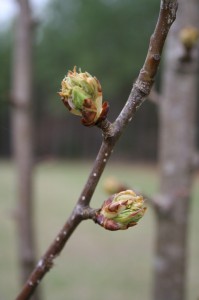 |
| Pear tree blossoms |
So much for spring. My husband and I looked over pictures from last year at this time. Last year, the fruit trees bloomed on March 14. This year – snow. I walked out of church on Sunday to hail and sleet. By the time I got home, it was snowing and the fruit trees were covered with snow and ice. I’d had the foresight to cut some daffodils before the snow hit. At least my kitchen smelled like spring.
Can fruit trees survive the snow and ice? My friend and Master Gardening mentor Liz sent me a great link I wanted to share with you. It is to a chart called Critical Spring Temperatures for Tree Fruit Bud Development Stages. Okay, so not the sexiest name in the world…but an excellent chart nonetheless. It shows you just how cold it has to get, and at what stage, before the fruit tree buds get nipped by Freeze Miser. It looks like we should be okay. Whew!
I was surprised when the snow melted to see that the blossoms were still on the peach tree that had begun to flower. It’s going to be cold this week, but Sunday’s temperatures are going back up to 60. I can tell you one thing; if it gets warm and they bloom on a nice spring day, I’ll be out there with my camera taking pictures!




